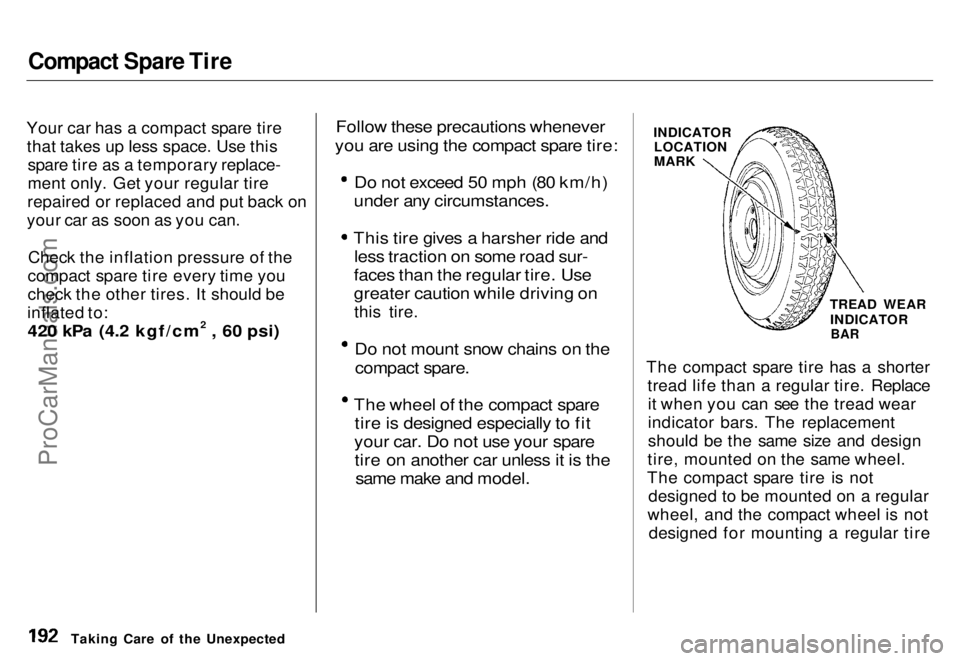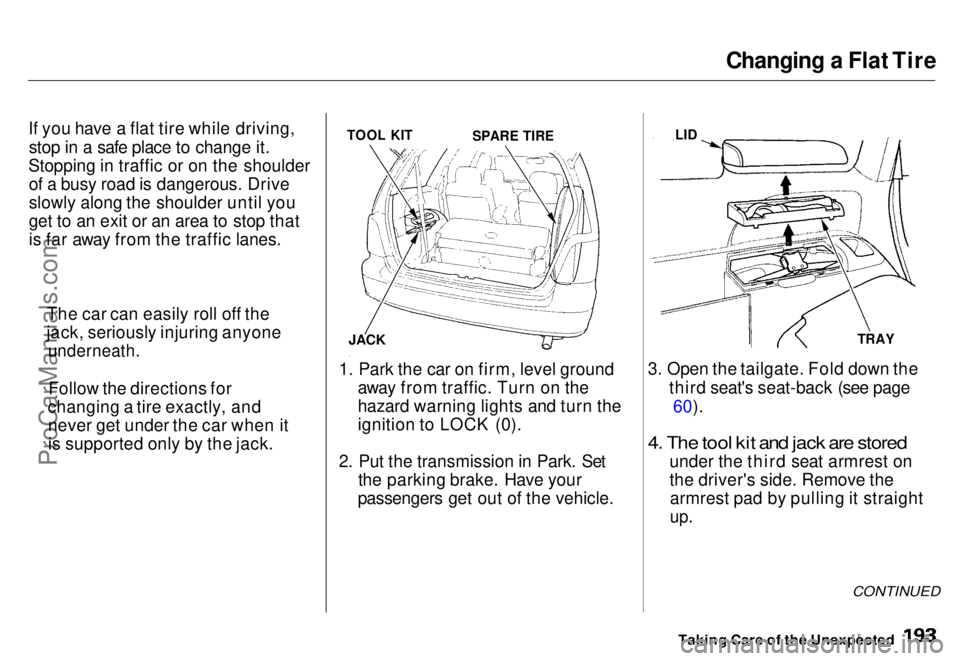Page 190 of 240

Compact Spare Tire
Your car has a compact spare tire that takes up less space. Use this spare tire as a temporary replace-
ment only. Get your regular tire
repaired or replaced and put back on
your car as soon as you can.
Check the inflation pressure of the
compact spare tire every time you
check the other tires. It should be
inflated to:420 kPa (4.2 kgf/cm2 , 60 psi)
Follow these precautions whenever
you are using the compact spare tire:
Do not exceed 50 mph (80 km/h)
under any circumstances.
This tire gives a harsher ride and
less traction on some road sur-
faces than the regular tire. Use
greater caution while driving on
this tire.
Do not mount snow chains on the
compact spare.
The wheel of the compact spare
tire is designed especially to fit
your car. Do not use your spare tire on another car unless it is the
same make and model.
INDICATOR
LOCATION
MARK
TREAD WEARINDICATOR
BAR
The compact spare tire has a shorter tread life than a regular tire. Replaceit when you can see the tread wear
indicator bars. The replacement
should be the same size and design
tire, mounted on the same wheel.
The compact spare tire is not designed to be mounted on a regular
wheel, and the compact wheel is not designed for mounting a regular tire
Taking Care of the Unexpected
ProCarManuals.coms t Main Menu Table of Contents
Page 191 of 240

Changing a Flat Tire
If you have a flat tire while driving, stop in a safe place to change it.
Stopping in traffic or on the shoulder of a busy road is dangerous. Drive
slowly along the shoulder until you
get to an exit or an area to stop that
is far away from the traffic lanes. TOOL KIT
JACK
1. Park the car on firm, level ground away from traffic. Turn on the
hazard warning lights and turn the
ignition to LOCK (0).
2. Put the transmission in Park. Set the parking brake. Have your
passengers get out of the vehicle. LID
TRAY
3. Open the tailgate. Fold down the third seat's seat-back (see page60).
4. The tool kit and jack are stored
under the third seat armrest on
the driver's side. Remove thearmrest pad by pulling it straight
up.
CONTINUED
Taking Care of the Unexpected
SPARE TIRE
The car can easily roll off the
jack, seriously injuring anyone
underneath.
Follow the directions for
changing a tire exactly, and never get under the car when it
is supported only by the jack.ProCarManuals.comMain Menu s t Table of Contents
Page 192 of 240
Changing a Flat Tire
5. Remove the tools from the tray. Remove the tray by pulling itstraight up.
6. Loosen the jack from its holder by turning the end counterclockwise.Remove the jack from the
compartment. 7. Unzip the spare tire cover.
STORAGE BIN
8. Unscrew the wing bolt. Remove the storage bin and spare tire.
Taking Care of the UnexpectedProCarManuals.comMain Menu s t Table of Contents
Page 193 of 240
Changing a Flat Tire
9. Loosen the five wheel nuts 1/2
turn with the wheel wrench.
LX model:
Do no
t attempt to forcibly pry the
wheel cover off with a screwdriver or
other tool. The wheel cover
cannot b
e removed without first
removing
the wheel nuts. 10.Find th
e jacking point nearest the
wheel yo
u are removing. Place th e
jac
k under the jacking point. Turn
the en
d bracket clockwise until
the
top of the jack contacts the
jacking point. Make sure the
jacking point tab is resting in the jack notch. 11.Use the extension and wheel
wrench as shown to raise
the car
until the flat tire is off the ground.
CONTINUED
Taking
Care of the Unexpected
WHEEL
NUTS
JACKING POINT WHEEL WRENC
H
EXTENSION
ProCarManuals.comMain Menu s t Table of Contents
Page 194 of 240
Changing a Flat Tire
12.Remove the wheel nuts and flat tire. Temporarily place the flat tireon the ground with the outside
surface of the wheel facing up.
You could scratch the wheel if you put it face down. BRAKE HUB
13.Before mounting the spare tire, wipe any dirt off the mountingsurface of the wheel and hub with
a cloth.
14.Put on the spare tire. Put the
wheel nuts back on finger-tight,then tighten them in a crisscross
pattern with the wheel wrenchuntil the wheel is firmly against
the hub. Do not try to tighten
them fully.
Taking Care of the UnexpectedProCarManuals.comMain Menu s t Table of Contents
Page 195 of 240
Changing a Flat Tire
15.Lower the car to the ground and remove the jack.
16.Tighten the wheel nuts securely in
the same crisscross pattern. Have
the wheel nut torque checked at
the nearest automotive service
facility.
Tighten the wheel nuts to:
108 N.m (11 kgf.m , 80 Ibf.ft)
17.Put the flat tire in the supplied vinyl bag.
E
X model:
Remove the center cap.
CONTINUED
Taking Care of the Unexpected
ProCarManuals.comMain Menu s t Table of Contents
Page 196 of 240
Changing a Flat Tire
18.Remove the spacer cone from the wing bolt, turn it over, and put itback on the bolt.
19.Install the flat tire and storage bin on the side panel as shown. Secure
them by screwing the wing boltback into its hole. 20.Put the spare tire cover in the
storage bin.
21. Knot the top of the vinyl bag as
shown.
22.Store the jack in its holder. Turn
the jack's end bracket clockwise to
lock it in place. Replace the tool
tray and store the tool kit. Installthe armrest pad.
23.Store the wheel cover or center cap in the cargo area. Make sure it
will not get scratched or damaged.
Taking Care of the Unexpected STORAGE BINProCarManuals.comMain Menu s t Table of Contents
Page 211 of 240

Towing
If your car needs to be towed, call a
professional towing service or, if you
belong to one, an organization that
provides roadside assistance. Never tow your car behind another car with
just a rope or chain. It is very
dangerous.
Emergency Towing
There are three popular methods of towing a car:
Flat-bed Equipment — The operator
loads your car on the back of a truck.
This is the best way of trans- porting your Honda.
Wheel Lift Equipment — The tow
truck uses two pivoting arms that go
under the tires (front or rear) and lift them off the ground. The other two
tires remain on the ground.
Sling-type Equipment — The tow
truck uses metal cables with hooks on the ends. These hooks go around
parts of the frame or suspension and
the cables lift that end of the car off
the ground. Your car's suspension and body can be seriously damaged
if this method of towing is attempted.
If your Honda cannot be transported by flat-bed, it should be towed with
the front wheels off the ground. Ifdue to damage, your car must be
towed with the front wheels on the ground, do the following:
Release the parking brake.Start the engine.
Shift to D4, then to N.
Turn off the engine.
Improper towing preparation will
damage the transmission. Follow the
above procedure exactly. If you cannot
shift the transmission or start the engine, your car must be transported
on a flat-bed.
It is best to tow the car no fartherthan 80 km (50 miles), and keepthe speed below 35 mph (55
km/h).
Trying to lift or tow your car by the
bumpers will cause serious damage.
The bumpers are not designed to
support the car's weight.
Taking Care of the Unexpected
NOTICE
NOTICEProCarManuals.comMain Menu s t Table of Contents